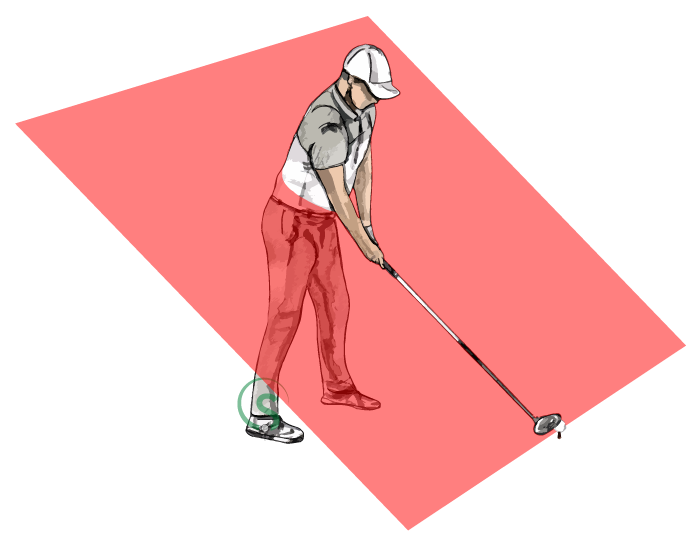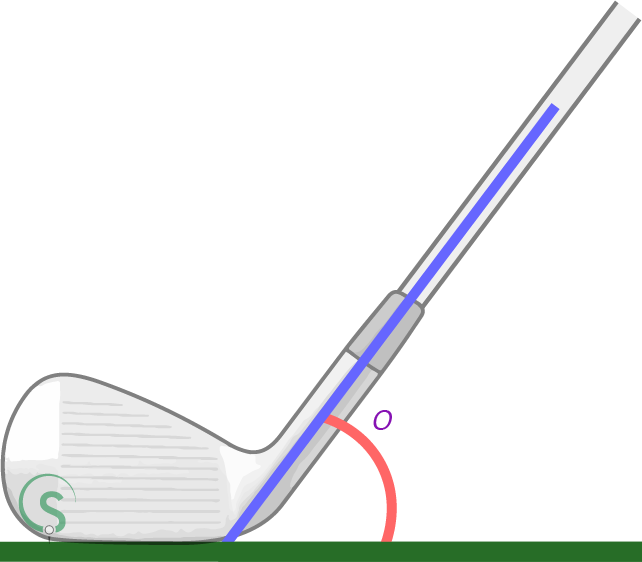The Swing Plane
The swing plane is a concept you’re probably familiar with. It’s discussed everywhere from Ben Hogan’s classic instruction book(1) to when TV commentators draw coloured lines on slow-motion swings.
In The Golfing Machine, Mr Kelley describes the swing plane as: “...a flat, inflexible, Inclined Plane which extends well beyond the circumference of the Stroke - in every direction. The full length of the Clubshaft remains unwaveringly on the face of this Inclined Plane - Waggle to Follow-through.”(2)
Mr Kelley later goes on to say: “Always view the Plane as rectangular (with four 90-degree corners), so, depending on the terrain and the situation at hand, the lower edge may be downhill, uphill, level, partially underground or above ground... But tilted, rotated or whatever, always have an Inclined Plane and a straight Plane Line.”(3)
In The Golfing Machine, Mr Kelley describes the swing plane as: “...a flat, inflexible, Inclined Plane which extends well beyond the circumference of the Stroke - in every direction. The full length of the Clubshaft remains unwaveringly on the face of this Inclined Plane - Waggle to Follow-through.”(2)
Mr Kelley later goes on to say: “Always view the Plane as rectangular (with four 90-degree corners), so, depending on the terrain and the situation at hand, the lower edge may be downhill, uphill, level, partially underground or above ground... But tilted, rotated or whatever, always have an Inclined Plane and a straight Plane Line.”(3)

So with our swing plane perfectly flat, creating a straight plane line along the ground, as per the third Basic Imperative,(4) what can we do with it? Firstly, we can decide the orientation of the swing plane - where the plane line is pointing. It could be open to the target (i.e. rotated anticlockwise for a right-handed golfer), closed to the target (rotated clockwise), or indeed parallel to the target, so the plane line points to where you want the ball to go. An important point to consider here is that the plane line is separate from your stance line.
Most people, if told to open their swing plane line, will do so by rotating their whole body at address. This isn’t necessary. You can align your stance parallel to the target line and still swing the clubshaft on a plane open to the target line. Or indeed any combination of an open, square or closed stance with an open, square or closed swing plane.(5)
With our swing plane’s orientation fixed, what else can we do with it? We can decide how steep or shallow the swing plane will be. Mr Kelley defined five swing planes each with different characteristics and steepnesses. Before we look at those, let’s look at another important plane we as golfers have no control over when out on the course.
Our golf clubs, most noticeably the irons and wedges, each have their own unique natural plane. This can be measured when the clubhead is perfectly soled - placed flat on the ground. You’re probably thinking a golf club can’t be placed flat on the ground because they have rounded bottoms, not square. You’d be quite right. They’re designed this way to accommodate the club being swung on different planes of steepness. Despite this, there is still only one way to sole a club properly and this puts the clubshaft on a particular inclined plane.
Most people, if told to open their swing plane line, will do so by rotating their whole body at address. This isn’t necessary. You can align your stance parallel to the target line and still swing the clubshaft on a plane open to the target line. Or indeed any combination of an open, square or closed stance with an open, square or closed swing plane.(5)
With our swing plane’s orientation fixed, what else can we do with it? We can decide how steep or shallow the swing plane will be. Mr Kelley defined five swing planes each with different characteristics and steepnesses. Before we look at those, let’s look at another important plane we as golfers have no control over when out on the course.
Our golf clubs, most noticeably the irons and wedges, each have their own unique natural plane. This can be measured when the clubhead is perfectly soled - placed flat on the ground. You’re probably thinking a golf club can’t be placed flat on the ground because they have rounded bottoms, not square. You’d be quite right. They’re designed this way to accommodate the club being swung on different planes of steepness. Despite this, there is still only one way to sole a club properly and this puts the clubshaft on a particular inclined plane.

The clubhead is properly placed on the ground when the leading edge of the clubface, and the normal to the clubface are both square to the target line. This is explained in the “Normal to Clubface” link in the D Plane chapter of this website.(6) This concept is important to understand when dealing with swing planes, because although you may swing the club on almost whatever plane you see fit, in reality the “best” plane to swing on is your golf club’s particular soled-to-the-ground plane. The reason being, it’s the only plane where a squared leading edge at separation produces a ball flight starting on the target line. If you were to swing on a plane steeper that the club’s natural plane, a square clubface leading edge at separation will cause the ball to start its flight right of target. Vice versa, a shallower plane will cause the ball to start its flight left of target.
So even with all things being correct; the “flat” left wrist, clubhead lag, straight plane line, a square clubface at separation, et cetera et cetera... you could still end up missing your target if you’re not swinging on the golf club’s natural plane through impact. That’s another reason golf is so hard, and why it’s so important to know how to set up to the ball, and to have clubs that fit your swing.
Now on to the five swing planes defined by Mr Kelley, starting with the Elbow Plane.
So even with all things being correct; the “flat” left wrist, clubhead lag, straight plane line, a square clubface at separation, et cetera et cetera... you could still end up missing your target if you’re not swinging on the golf club’s natural plane through impact. That’s another reason golf is so hard, and why it’s so important to know how to set up to the ball, and to have clubs that fit your swing.
Now on to the five swing planes defined by Mr Kelley, starting with the Elbow Plane.
